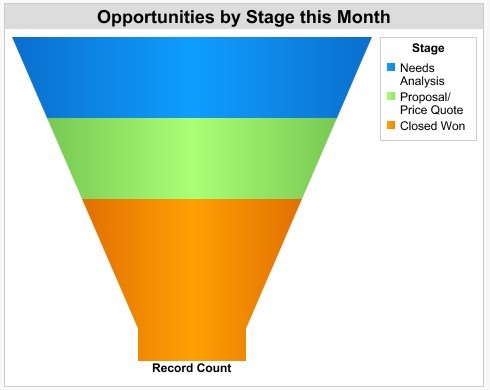Building a healthy sales pipeline is critical if you want to attain your revenue goals 3, 6, or 9 months from now…
So what steps should you take to build and sustain a HEALTHY sales pipeline all year long?
- Start with ENOUGH Leads
We all know that sales is a “numbers game.” To develop a healthy sales pipeline, you MUST start with enough leads to process through your marketing and sales engine. After all, only a portion will become “qualified leads,” and of those, only a fraction will be ready to buy now.
So – it is PARAMOUNT that you add ENOUGH targeted leads into the top of your marketing and sales engine!
Do you honestly have enough leads to achieve ongoing sales success??
Are you using LinkedIn, or “referral-based marketing” as your primary source of leads? If so, your sales pipeline probably looks dismal! How many suspects are in your lead pool today? 100? 300? That’s not nearly enough to create a healthy pipeline.
To generate enough qualified leads, you must market regularly to a much larger database of targeted contacts…
- Qualify Every Lead
Next, qualify each interested lead. (You don’t want a bunch of tire kickers clogging up your pipeline!)
Generate your own list of qualifying questions to ask every prospect. Determine if there is a real business opportunity there or not, and assign a resulting lead quality of A, B, or C to each.
Do they have a real need you can fill? Ask prospects:
- What are your major challenges in this area? What keeps you up at night?
- Have you tried to solve these issues? If so, how?
- How soon do you want to find a solution?
- What solutions would you consider?
- What is the budget to address the situation?
- Is anyone else involved in making a final decision on this?
Use open-ended probing questions to determine the extent of their needs.
- Are their needs beyond the scope of your offering? If so, refer them to a partner resource.
- Are they the sole decision-maker? If not, get the real decision-maker involved in the process early. (Don’t let your contact “sell internally on your behalf” – that is NEVER good.)
- Do they appear to have little or no budget? Mark them as a “C” lead and move on to other prospects.
- Stay focused and know when to move on/walk away.
Targeted Marketing Using Lead Quality: Use the Lead Quality data you’ve gathered, you can now develop more targeted marketing campaigns to boost results. For example, ‘A’ leads may receive more frequent or targeted email campaigns than ‘C’ leads.
- Nurture Qualified Prospects
Not every qualified prospect will be ready to buy today. Once you have identified “qualified prospects,” leverage the use of content-based email marketing to continue to nurture leads and identify interested prospects. Continue to provide value at every touch.
Create a “Next Step” for EVERY qualified prospect. What is the best next step based on their need/interest/timing?
- Schedule a demo or follow-up call to share additional insights
- Send a follow-up email with value-added content and add a tickler note to follow up in X time period
- Send an industry-related article every 3-4 weeks to stay in touch
Remain in front of qualified prospects regularly so that when that elusive time of need arises, you’ll be there to assist. ALWAYS schedule the next step. Continue to move each lead through the sales process to build your sales pipeline! – Jae-ann Rock
- CRM System & Your Sales Pipeline
Diligent use of a CRM system is imperative to track all lead, prospect, and customer activity. Here are a few CRM setup tips to streamline your marketing efforts:
- Set up and maintain a field to track lead quality (A/B/C)
- Map your organization’s sales process, then customize your CRM system to match that process:
- Qualification – 10%
- Needs Analysis – 35%
- Proposal – 75%
- Negotiation – 90%
- Closed Won – 100%
- Closed Lost – 0%
- Track every sales Opportunity
A healthy sales pipeline will have the following attributes:
- A number of opportunities are at every stage of the funnel
- A continuous flow of NEW opportunities are coming into the top of the funnel every month
- NEW opportunities are being added to the sales funnel every month!
It is helpful to visually gauge how the sales pipeline is shaping up – by rep, by product line, or as a company overall.
Here is an example of a very basic sales pipeline chart with three simple opportunity stages:
Remember, there should be a number of opportunities at every stage, AND those opportunities must be moving THROUGH the pipeline stages for a pipeline to be considered healthy!
- Is your pipeline top-heavy with no opportunities in the last stages? Why?
- Is your pipeline bottom heavy? Why?
- Without enough opportunities entering the top of the funnel, you will have a revenue shortfall in 3, 6, or 9 months.
- Identify & Move “Stuck Opportunities”
WHERE DO DEALS GET STUCK?
Identify stalled or stuck opportunities ASAP and find ways to move them forward to keep the pipeline healthy. Run an Opportunity Aging report by Stage. Dig into the data to discover trends.
- Are there common points in the process where deals become lost or stuck? Why?
- Identify and resolve the root cause(s) of the “stuck” or “lost” opportunities, to reduce sales cycle time and move opportunities forward.
- Provide additional sales training to resolve specific issues.
- Is an individual rep having trouble closing deals? What are the barriers to closing?
- Provide additional training as needed based on the following possible root causes:
- Is the contact an “influencer” and not a decision-maker?
- Did the rep properly probe to uncover the prospect’s real needs and objections?
- Did the prospect raise new objections at the time of closing?
- Should you institute an expiration date on all proposals to create urgency?
- Does your proposal inadvertently derail the sale? (This happens more often than you might think!)
Identify and rectify any areas of trouble in the sales cycle to keep the flow of qualified leads moving forward to closed deals.
_______________________
Here’s the bottom line – building a healthy sales pipeline requires that you develop a lead generation and sales strategy and then execute that strategy on a daily, weekly, monthly basis.
Need help?? Call us today for a free assessment: 888-887-0556.
SunStream Consulting Group – Helping companies grow since 2001.
